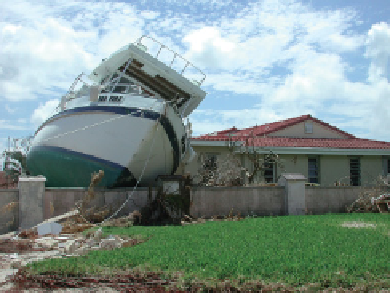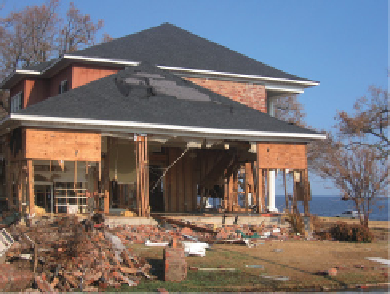Environmental Engineering Reference
In-Depth Information
Figure 2.4
Damage caused by hurricanes in the USA.
Photos: Munich RE Group.
Examples of Major Natural Catastrophes
■
Winter 1990:
The storms Daria, Herta, Vivian and Wiebke kill 272
people in Europe and cause 12.8 billion euros in damage.
■
29 April 1991:
A storm tide resulting from the tropical cyclone Gorky hits
Bangladesh. 138 000 people die. The material damage at 3 billion euros is compara-
tively low in this poor country.
■
12 December 1999:
Storm Lothar devastates large areas of Europe. 110 people die.
The damage amounts to 11.5 billion euros.
■
August 2002:
Unusually heavy rainfall with up to 400 litres per square metre causes
major fl ooding. In Germany, Dresden is one of the cities overcome by fl oods. In
Europe overall 230 people lose their lives and the damage is 18.5 billion euros.
■
August 2003:
Europe's most extreme heatwave in recorded history takes 70 000
lives and causes damage close to 13 billion euros.
■
August 2005:
Hurricane Katrina wreaks havoc in the USA and destroys the city of
New Orleans. 1322 people die as a result. The most expensive storm of all time
causes US$125 billion (around 100 billion euros) worth of damage.
■
September 2005:
Four weeks after Katrina, Hurricane Rita causes around 13 billion
euros worth of damage. About 3 million people are evacuated to protect the
population.
■
18 January 2007:
The storm Kyrill moves across Europe. The German railway halts
all train travel in Germany for the fi rst time in history.
Extreme weather events also bring about a rise in the death rate. In the summer of
2003 about 70 000 more people died in Europe than in a normal year, as a result of
the excessive heat.
Although the fi nancial damage resulting from natural catastrophes is still manage-
able at the moment in Europe, these fi gures are expected to rise dramatically by the
end of the century. The German Institute for Economic Research DIW projects that





